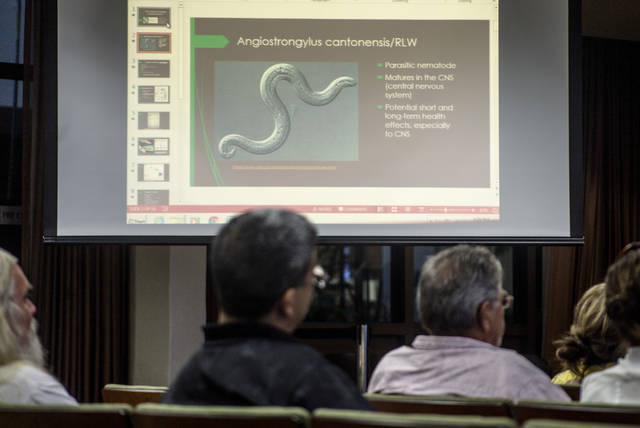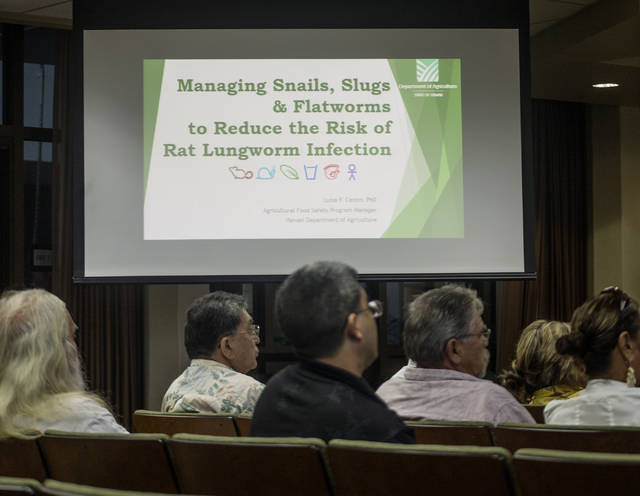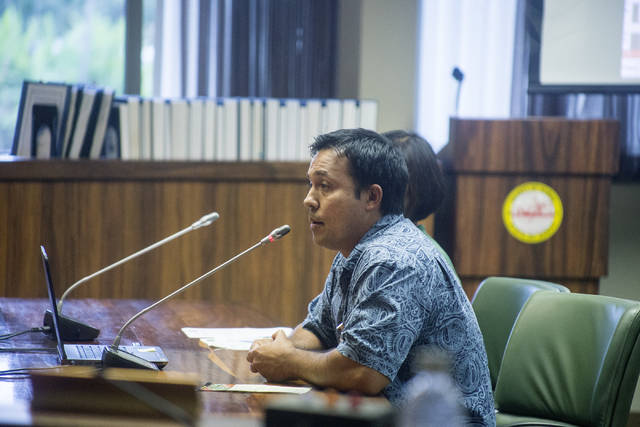State announces launch of rat lungworm public health campaign
Hawaii health officials will use $1 million from the state Legislature to study rat lungworm prevalence in rats and fund a public information campaign targeting residents and tourists.
ADVERTISING
“The departments of Health and Agriculture have been leading the state’s efforts to increase awareness of the serious and debilitating disease,” Gov. David Ige said Wednesday during a Facebook live news conference.
“Our departments are collaborating to educate people about prevention and to raise the safety and quality control standards followed by our farmers, retailers and food establishments so that we can continue to buy local, while taking basic precautionary measures to safeguard consumers,” he said.
Some of the state funds, which will be spent in the next two years, were used to develop a series of TV and radio announcements that will air through October, targeting farmers and gardeners. A food safety coordinator also was hired.
During the news conference, state Health Director Dr. Virginia Pressler played one of the new public service announcements, which said rat lungworm in humans can be prevented by “simply washing” produce.
But University of Hawaii at Hilo rat lungworm researcher Sue Jarvi, who was bypassed by the Legislature when money intended for her research instead went to the DOH, took umbrage at that approach.
“They say wash your produce. Yes, washing your produce is better than not washing your produce. It makes it safer — but it doesn’t make it safe,” Jarvi, a professor, said during an interview after she saw Ige’s live news conference.
There has not been a study that demonstrates washing produce prevents rat lungworm, she said.
But the DOH, responding to inquiries from the Tribune-Herald, said “washing raw vegetables and fruits thoroughly under running water before eating not only prevents rat lungworm, but also rinses off other contaminants.”
The DOH said it has been providing information about rat lungworm “during community meetings and other forums at community centers, garden clubs, health fairs, schools, churches, etc.” Advisories were sent to physicians statewide, and fliers were distributed at farmers markets.
Humans get rat lungworm by eating fresh produce such as leafy greens that contain slugs, which often are hard to see. Slugs get the larvae by eating rat feces. Humans who eat a slug and become infected with rat lungworm can experience symptoms such as transient skin pain, headaches and other neurological problems.
Pressler said there are plans to conduct a statewide, concurrent survey of rats, slugs and snails to learn the prevalence of rat lungworm among them, and to learn why rat lungworm disease occurs in humans in some places but not in others — even though slugs and snails throughout the state carry the parasite. Survey findings will be used to guide public health efforts in the second year of funding, she said.
“A statewide survey of this kind has never been conducted in Hawaii before,” she said. “And we hope to gather information on the disease risk of not only rat lungworm, but also diseases like leptospirosis and murine typhus, which we know are also carried by rats in Hawaii. We hope to learn the extent of these diseases in our state and the related risk factors.”
Leptospirosis is a bacterial disease that can cause neurological symptoms and kidney damage if left untreated. Murine is a type of typhus transmitted by rat fleas.
Two full-time staffers will be hired, Pressler said, to coordinate the survey and any public-private partnerships that develop. They’ll also follow up on reports of slug or snail infestations in produce.
Jarvi said she is pleased the state plans a study.
She said she tested 545 rats “captured in the Hilo area” and 94 percent of them were positive for rat lungworm infestation.
“That’s an outrageously high rate,” she said, noting 70 percent of semi-slugs contain rat lungworm larvae. But she would like to see the comprehensive statewide data.
Pressler said the Department of Health, with support of the governor, will lead a “coordinated response” to the rat lungworm outbreak, which has been confirmed in 15 people so far in 2017 — the “highest number of cases reported in the state over the last decade.”
“I’m glad that, finally, the state seems like they’re taking this seriously,” Jarvi said. “And I’m glad they’re going to do something, rather than nothing.”
On Tuesday, Jason Dela Cruz, public health educator, presented some of the DOH’s outreach efforts to the Hawaii County Council.
Puna Councilwoman Eileen O’Hara said she’d like to see more funds spent on research, particularly on the effectiveness of catchment tank filters, and not just on education.
“If that’s all we’re doing is passing out educational material, when we still don’t know these answers, it is still not enough,” she said.
Dela Cruz acknowledged more research needs to be done to combat the disease but noted public education also is important.
“This has to be done at all levels,” he said.
The DOH recommends residents maintain their catchment tanks with good covers to make it more difficult for slugs to crawl inside.
Reporter Tom Callis contributed to this report.
Email Jeff Hansel at jhansel@hawaiitribune-herald.com.





